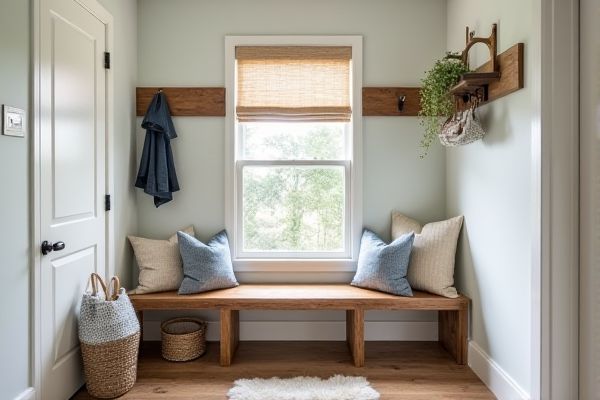
Faux wood benches offer affordability and resistance to moisture and scratches, making them ideal for high-traffic mudrooms, while solid wood benches provide unmatched durability and a classic, natural aesthetic that can be refinished over time. Discover the best choice to enhance Your mudroom's functionality and style by reading the rest of the article.
Table of Comparison
| Feature | Faux Wood Bench | Solid Wood Bench |
|---|---|---|
| Material | Synthetic materials mimicking wood grain | Natural hardwood or softwood |
| Durability | Resistant to moisture and scratches | Strong, can last decades with proper care |
| Maintenance | Easy to clean, low upkeep | Requires polishing and protection from moisture |
| Cost | Generally more affordable | Higher initial investment |
| Appearance | Consistent pattern, less natural look | Unique grain, authentic and warm |
| Weight | Lighter and easier to move | Heavier, more solid feel |
| Environmental Impact | Often made from recycled or synthetic materials | Biodegradable but involves tree harvesting |
Introduction: Faux Wood vs Solid Wood Benches for Mudrooms
Faux wood benches in mudrooms offer durability and moisture resistance, making them ideal for high-traffic, damp environments. Solid wood benches provide natural beauty, unique grain patterns, and long-lasting strength but require more maintenance to prevent warping and damage. Choosing between faux wood and solid wood depends on balancing budget, aesthetic preference, and environmental conditions in the mudroom.
Aesthetic Appeal: Comparing Visual Styles
Faux wood benches in mudrooms offer consistent grain patterns and color uniformity, creating a sleek and modern aesthetic ideal for minimalist and contemporary designs. Solid wood benches showcase natural variations, knots, and textures that provide a warm, rustic charm and an authentic, timeless appeal. Choosing between faux and solid wood hinges on the desired visual style, with faux emphasizing uniformity and ease of customization, while solid wood highlights natural beauty and unique character.
Durability and Longevity in High-Traffic Areas
Faux wood benches in mudrooms offer enhanced resistance to moisture, scratches, and stains, making them highly durable in high-traffic areas where wear and tear are common. Solid wood benches provide natural strength and longevity but may require regular maintenance such as sealing or refinishing to prevent damage from humidity and heavy use. Choosing faux wood maximizes durability with minimal upkeep, while solid wood emphasizes timeless aesthetics and structural integrity when properly cared for.
Maintenance and Cleaning Requirements
Faux wood benches in mudrooms require minimal maintenance, as they resist stains, scratches, and moisture, making cleaning with mild soap and water quick and easy. Solid wood benches demand regular care, including periodic polishing or sealing to protect against moisture damage and scratches, along with careful cleaning to avoid surface wear. Choosing between the two depends on balancing the ease of maintenance with the authentic look and feel of natural wood.
Cost Comparison: Faux Wood vs Solid Wood
Faux wood benches typically cost significantly less than solid wood benches, making them a budget-friendly choice for your mudroom. While solid wood benches offer durability and natural aesthetics, they come with higher material and craftsmanship expenses. Investing in faux wood can provide the look of real wood at a fraction of the price, ideal for cost-conscious homeowners.
Environmental Impact and Sustainability
Faux wood benches typically have a lower environmental impact due to their use of synthetic or recycled materials, reducing the need for harvesting timber and preserving natural forests. Solid wood benches are often more sustainable when sourced from responsibly managed forests with certifications like FSC, as they are biodegradable and can be repaired or refinished to extend their lifespan. Your choice may depend on balancing recycled content and resource regeneration with durability and end-of-life disposal.
Weight and Ease of Relocation
Faux wood benches are significantly lighter than solid wood benches due to their composite materials, making relocation in your mudroom easier and less strenuous. Solid wood benches, while heavier and more durable, may require extra effort or assistance to move, impacting flexibility in your space arrangement. Your choice depends on balancing weight for ease of movement with the solid wood's timeless aesthetic and sturdiness.
Resistance to Moisture and Temperature Changes
Faux wood benches offer superior resistance to moisture and temperature changes compared to solid wood benches, making them ideal for mudrooms where humidity and temperature fluctuate frequently. Unlike solid wood, which can warp, crack, or swell when exposed to moisture, faux wood materials are engineered to withstand these conditions without compromising structural integrity. Choosing a faux wood bench ensures your mudroom seating remains durable and attractive even in challenging environments.
Customization Options and Design Flexibility
Faux wood benches offer a wide range of customization options and design flexibility due to their versatile manufacturing processes, allowing for varied colors, textures, and finishes that can mimic multiple wood species. Solid wood benches provide unique, natural grain patterns and can be expertly handcrafted, giving your mudroom an authentic, one-of-a-kind look that can be personalized through stains and carvings. Choosing between the two depends on whether you prioritize extensive design versatility with faux wood or the distinctive character and customization potential inherent in genuine solid wood.
Verdict: Choosing the Best Bench for Your Mudroom
Faux wood benches offer durability and affordability, making them ideal for high-traffic mudrooms prone to moisture and dirt. Solid wood benches provide timeless elegance and strength, often featuring natural grain patterns that enhance aesthetic appeal but require regular maintenance. For mudrooms, selecting a bench depends on balancing practical wear resistance against desired style and upkeep commitments.
 homyna.com
homyna.com